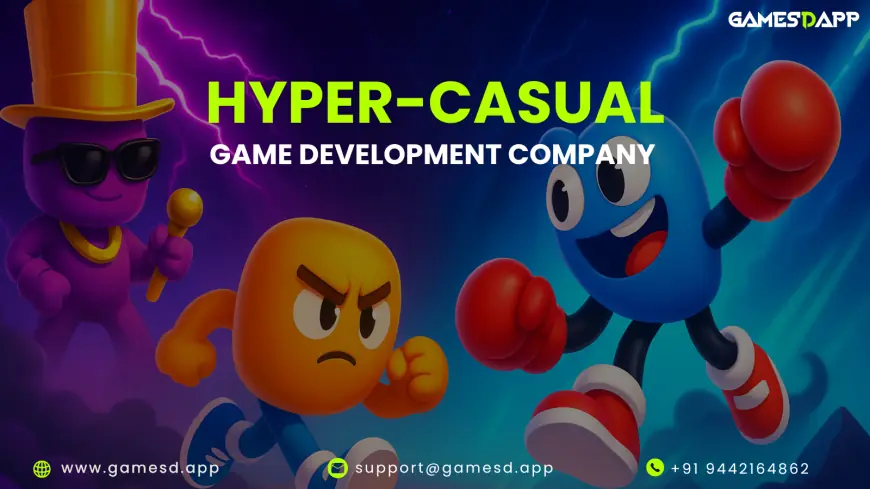5 Proven Strategies for Successful Hyper Casual Game Development
Uncover five proven strategies that help developers create engaging, profitable, and market-ready hyper casual games.

Hyper casual games have taken the gaming world by storm, topping charts and winning millions of daily active players across the globe. Their magic lies in being easy to play yet impossible to put down. But behind every successful title is a carefully thought-out process that blends creativity, simplicity, and strategy. Let’s break down the core elements that make these games thrive and how the right approach can turn a simple idea into the next viral hit.
The Secret Behind Hyper Casual Game Success
Ever wondered why hyper casual games dominate the top charts on app stores? It’s because they are quick, addictive, and accessible to absolutely everyone. Hyper Casual Game Development is all about keeping things light, fun, and instantly rewarding. Unlike complex RPGs or shooters, these games thrive on simplicity, which makes them perfect for today’s fast-scrolling, short-attention-span players. But behind every “simple” game lies a smart strategy that ensures it captures and retains attention.
1. Simplicity That Keeps Players Coming Back
The golden rule of hyper casual gaming? Keep it simple. These games are designed for instant fun without complicated rules or steep learning curves. Whether it’s tapping, swiping, or dragging, the mechanics are straightforward but deeply engaging. Great Hyper Casual Game Developers know that every extra button or confusing instruction increases the chances of losing a player.
-
Easy controls = higher retention
-
One core mechanic = instant focus
-
Short sessions = more frequent play
-
Endless replay value = long-term success
When combined, these elements give players exactly what they’re looking for: quick entertainment in the palm of their hands.
2. Instant Onboarding: Engaging Players From the First Tap
In hyper casual games, the first 10 seconds are make-or-break. If players can’t understand the game right away, they’ll uninstall before giving it a chance. That’s where onboarding comes in. A well-designed onboarding process introduces gameplay naturally, without lengthy tutorials.
For example, instead of explaining controls through multiple screens, the game can simply let the player tap once and immediately start playing. This design mindset is what separates winning titles from the ones that vanish unnoticed.
3. Design That Delivers: Visuals and Flow That Feel Effortless
It’s not about flashy graphics; it’s about clear and smooth visuals. Players should instantly know what’s happening on the screen and what action they need to take. In Mobile Game Development, hyper casual games focus on visuals not just for beauty but for guiding the player’s attention seamlessly.
Good design balances three key elements:
Clean, Uncluttered Layouts
A simple layout makes it easy for players to focus on the core mechanic without distractions. In hyper casual games, clarity always beats complexity.
Bright, Engaging Color Palettes
Colors aren’t just for aesthetics; they grab attention and set the mood. The right palette keeps players visually hooked while guiding their actions.
Flow That Keeps Players in the Zone
Smooth transitions and intuitive gameplay flow ensure players stay immersed. When a game “feels right,” players are more likely to come back for repeat sessions.
4. Testing, Tweaking, and Learning From Player Data
The best developers know that creating a successful game isn’t just about building, it’s about improving. Hyper casual titles undergo constant testing and optimization based on real-world player data. This involves monitoring metrics like session length, drop-off rates, and in-app actions.
Data-driven insights help developers refine mechanics, adjust difficulty levels, and even redesign visuals if needed. This process of rapid prototyping for hyper casual games ensures that the final product hits the sweet spot between fun and challenge.
5. Earn Smart: Monetization Without Annoying Gamers
Monetization is a sensitive part of Hyper Casual Game Development. Too many ads or poorly timed pop-ups can frustrate players and drive them away. The trick is to integrate monetization in a way that feels natural.
Popular methods include:
Rewarded Ads With Player Choice
These ads let players opt in to watch in exchange for bonuses. It feels like a fair trade and keeps engagement high without frustration.
Interstitial Ads at Natural Breaks
Placed between levels or sessions, these ads don’t interrupt gameplay. Instead, they blend naturally into the experience while still generating revenue.
In-App Purchases That Add Value
Cosmetics, power-ups, or progression boosts give players optional upgrades. When done right, these purchases enhance the fun without making the game feel pay-to-win.
Wrapping Up
Hyper casual gaming is booming, especially with Unity hyper casual game development and cross-platform launches on iOS and Android. For startups wondering how to develop a hyper casual mobile game from scratch, finding the best hyper casual game development company is the key.
That’s why many businesses choose GamesDapp, a trusted Hyper Casual Game Development Company. With skilled Hyper Casual Game Developers, they deliver custom, scalable, and profitable games. If you’re aiming to launch your next hit, GamesDapp is the best team to trust.
What's Your Reaction?
 Like
0
Like
0
 Dislike
0
Dislike
0
 Love
0
Love
0
 Funny
0
Funny
0
 Angry
0
Angry
0
 Sad
0
Sad
0
 Wow
0
Wow
0

























































